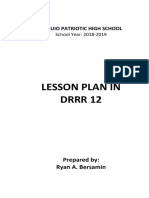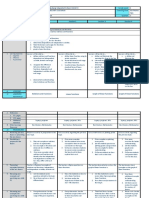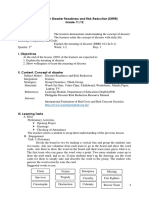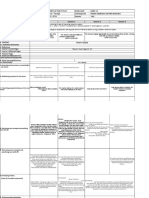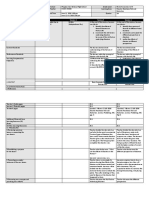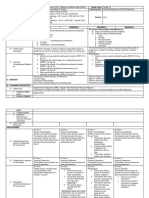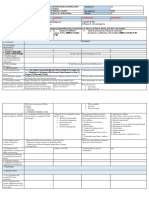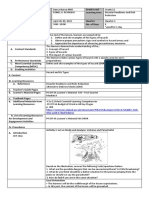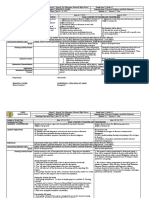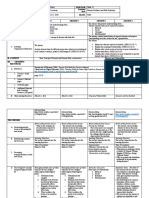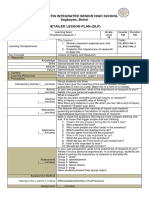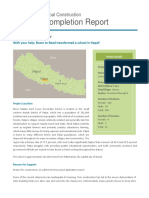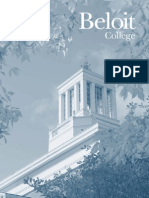DLL DRRR 3rd Week 1st Day
DLL DRRR 3rd Week 1st Day
Uploaded by
rexson de villaCopyright:
Available Formats
DLL DRRR 3rd Week 1st Day
DLL DRRR 3rd Week 1st Day
Uploaded by
rexson de villaOriginal Title
Copyright
Available Formats
Share this document
Did you find this document useful?
Is this content inappropriate?
Copyright:
Available Formats
DLL DRRR 3rd Week 1st Day
DLL DRRR 3rd Week 1st Day
Uploaded by
rexson de villaCopyright:
Available Formats
School Bayuin National High School Grade 12 MATATAG/11
Level Malikhain
JOVIE M. MAGCAMIT Learning Disaster Readiness and
Area Risk Reduction
GRADE 1 to 12
Teacher
DAILY LESSON LOG
Teaching November 19, 2018 Quarter First
Dates and 11:00-12:00
Time 1:00-2:00
Monday
I. OBJECTIVES 1. Identify safe and dangerous areas in terms of disasters.
2. describe these potential disasters.
A. Content Standards The learners demonstrate understanding of the concept of disaster and
disaster risk, and the nature and effects of disasters.
B. Performance Standards The learners shall be able to: • relate the concept of disaster with daily life.
C. Learning The learners are able to:
Competencies/ • describe the effects of disasters on one’s life (DRR11/12-Ia-b-3)
Objectives w/ LC code Identify areas/locations exposed to Identify areas/locations exposed
to hazards hazards that may lead to disasters; DRR11/12-Ia-b-5
II. CONTENT Basic concept of disaster and disaster and disaster risk
III. LEARNING RESOURCES
A. References
1. Teacher’s Guide pages Disaster Readiness and Risk Reduction pg. 22-26
2. Learner’s Materials pages Disaster Readiness and Risk Reduction
3. Textbook pages
4. Additional Materials for
Learning Resource (LR) portal Powerpoint presentation
B. Other Learning
Resources
IV. PROCEDURES
A. Reviewing previous When the Music Stops…..
lesson or presenting the 1. The learners will recap yesterday’s lesson through an activity.
new lesson The teacher will pass the ball the students while playing the music and the
music stops he students who will carry the ball should his learnings about the
B. Establishing a yesterday’s lesson.
purpose for the new lesson Hazard - A dangerous phenomenon, substance, human activity or
condition that may cause loss of life, injury or other health impacts,
property damage, loss of livelihoods and services, social and economic
disruption, or environmental damage.
Disaster - A serious disruption of the functioning of a community or a
society involving widespread human, material, economic, or
environmental losses and impacts which exceeds the ability of the
affected community or society to cope using its own resources.
C. Presenting examples/ Activity: Creating a Classroom Hazard Map
instances of the new 1. Individually, ask the learners to get out a piece of paper or their
lessons assigned activity notebook for writing.
2. Ask the learners to list 10 hazards in the classroom. Their answers
D. Discussing new should be specific to certain locations in the classroom (e.g. the shelf at
concepts and practicing the corner near the door can fall on someone). (5 minutes)
new skills #1 Rubrics:
Relevance – 10
Content – 10
E. Discussing new Presentation:
concepts and practicing 1. Each group will post their map in a designated area in the classroom using
new skills #2 masking tape. Reporters must be by their map at all times.
F. Developing mastery 2. The rest of the group will go around and listen to the reports of the other
(leads to Formative groups. They are encouraged to ask questions and make constructive reviews
Assessment 3) of their classmates’ works.
3. The scribe of each group should take note of potential hazards they might
have missed.
4. When everyone is done, debrief the activity.
G. Finding practical The students will answer this questions:
applications of I. What will you do should an earthquake happen?
concepts and skills in II. What can be done to prevent a disaster in the classroom?
daily living
H. Molding generalizations What did you learn from our lesson?
and abstractions about The students will share their experience related to the lessons.
the lesson
I. Evaluating learning The students will answer the following questions in their activity notebook.
1. Will a hazard always cause a disaster?
2. There is a volcano in the middle of an uninhabited desert. What is the
hazard? Will there be a human disaster if the volcano erupts?
Activities
J. Additional activities for Remedial
application and
remediation
V. REMARKS
VI. REFLECTIONS G12-Matatag G11-Malikhain
A. No. of learners who
earned 80% in the evaluation
B. No. of learners who
require additional activities for
remediation who scored below
80%.
C. Did the remedial lessons
work? No. of learners who have
caught up with the lesson.
D. No. of learners who
continue to require remediation
E. Which of my teaching
strategies worked well? Why did
these work?
F. What difficulties did I
encounter which my principal or
supervisor can help me solve?
G. What innovation or
localized materials did I
use/discover which I wish to share
with other teachers?
Checked/Inspected by Prepared by::
DAISY P. RIEGO JOVIE M. MAGCAMIT
PRINCIPAL II SHS-SST 1
You might also like
- Lesson Plan in DRRR 1st COTDocument5 pagesLesson Plan in DRRR 1st COTMercy Monarca100% (6)
- DLL DRRR Week 5Document3 pagesDLL DRRR Week 5Rizalyn Garcia100% (4)
- DRRR - ToS and Test Question - 2nd QuarterDocument6 pagesDRRR - ToS and Test Question - 2nd QuarterCP Yttrep91% (11)
- Alesson Plan in Disaster Readiness and Risk Reduction (DRRR) Grade 11/12Document63 pagesAlesson Plan in Disaster Readiness and Risk Reduction (DRRR) Grade 11/12Kennedy Fieldad Vagay100% (1)
- DRRR-Week 2Document7 pagesDRRR-Week 2Ren Andaleon Cortez100% (1)
- DRRR DLL 2nd Quarter - Week 2 Day 1 and 2Document4 pagesDRRR DLL 2nd Quarter - Week 2 Day 1 and 2Kristal Pearl Rosete100% (2)
- DLL DRRR Week 4Document3 pagesDLL DRRR Week 4Rizalyn Garcia50% (2)
- DRRR-Week 7Document5 pagesDRRR-Week 7Ren Andaleon CortezNo ratings yet
- Lesson Plan in DRRR 2nd COTDocument4 pagesLesson Plan in DRRR 2nd COTMercy Monarca0% (2)
- DRRR-Week 1Document9 pagesDRRR-Week 1Ren Andaleon Cortez100% (3)
- DLL - DRR Jan 29-Feb 2Document2 pagesDLL - DRR Jan 29-Feb 2Michelle Vinoray PascualNo ratings yet
- Lesson Plan in DRRR 12 2018-2019Document34 pagesLesson Plan in DRRR 12 2018-2019Ryan BersaminNo ratings yet
- DLL DRRR Week 6Document3 pagesDLL DRRR Week 6Rizalyn Garcia92% (13)
- DRRRM DLLDocument2 pagesDRRRM DLLMichelle Vinoray Pascual100% (4)
- Daily Lesson Plan in Disaster Readiness and Risk ReductionDocument7 pagesDaily Lesson Plan in Disaster Readiness and Risk ReductionRex Springfields Halipot Aguirre91% (11)
- DRRR Mid Term Exam 2018Document4 pagesDRRR Mid Term Exam 2018Ryan Negad100% (27)
- RA 9163 SummaryDocument3 pagesRA 9163 Summarygago ka100% (2)
- Daily Lesson LogDocument16 pagesDaily Lesson Loghonelyn r saguranNo ratings yet
- 2nd Quarter - Week 1 Day 1 - 27Document3 pages2nd Quarter - Week 1 Day 1 - 27Kristal Pearl Rosete100% (2)
- DLL DRRR 3rd Week 1st Day PDF FreeDocument2 pagesDLL DRRR 3rd Week 1st Day PDF FreeApril Mae ArcayaNo ratings yet
- DRRR 2nd Quarter - Week 1 Day 2Document3 pagesDRRR 2nd Quarter - Week 1 Day 2Kristal Pearl Rosete100% (2)
- DLP DRRR 1-26Document63 pagesDLP DRRR 1-26Zudota100% (12)
- DLL DRRR Docx FireDocument3 pagesDLL DRRR Docx FireRoseman TumaliuanNo ratings yet
- DLL DRRR Week 4 - 2020Document3 pagesDLL DRRR Week 4 - 2020Rizalyn Garcia100% (2)
- DLL DRRR Week 9Document3 pagesDLL DRRR Week 9Rizalyn Garcia100% (2)
- DLL DRRDocument4 pagesDLL DRRBhenjie Manuel100% (1)
- DLL Week 3 DRRMDocument4 pagesDLL Week 3 DRRMSon Ocampo100% (6)
- DRRR-Week 8Document6 pagesDRRR-Week 8Ren Andaleon Cortez100% (1)
- DRRR Week 111Document9 pagesDRRR Week 111Jimmy Velasco100% (1)
- DLL Week 2Document4 pagesDLL Week 2Son Ocampo100% (1)
- LP #1 Disaster Readiness and Risk ReductionDocument7 pagesLP #1 Disaster Readiness and Risk ReductionPerla Almalbis Bernardez100% (1)
- Bago City Senior High School Jerson I. Fortuna December: Daily Lesson LogDocument3 pagesBago City Senior High School Jerson I. Fortuna December: Daily Lesson LogJerson Riuku Fortuna100% (1)
- DLL DRRR Quarter 1 Week 2Document4 pagesDLL DRRR Quarter 1 Week 2Dionald MontesNo ratings yet
- DRRR-Week 5Document7 pagesDRRR-Week 5Ren Andaleon Cortez100% (1)
- Daily Lesson Plan in DRRR 12: I. ObjectivesDocument4 pagesDaily Lesson Plan in DRRR 12: I. ObjectivesJoanne Manlangit LañojanNo ratings yet
- Earthquake Hazard MWFDocument3 pagesEarthquake Hazard MWFAzeLuceroNo ratings yet
- 2nd Quarter - Week 4 Day 3 and 4 - 37Document4 pages2nd Quarter - Week 4 Day 3 and 4 - 37Kristal Pearl Rosete100% (1)
- DRRR Lesson Plan Q2 Week 1Document5 pagesDRRR Lesson Plan Q2 Week 1roberto limNo ratings yet
- DRR11 12 Ic D 34Document3 pagesDRR11 12 Ic D 34allanrnmanalotoNo ratings yet
- 2nd Quarter - Week 3 Day 2 - 33Document2 pages2nd Quarter - Week 3 Day 2 - 33Kristal Pearl RoseteNo ratings yet
- DLL DRRRDocument3 pagesDLL DRRRRenier Dela Vega Flores100% (3)
- First Quarter Examination TOS DRRRDocument2 pagesFirst Quarter Examination TOS DRRRnino83% (6)
- LESSON-EXEMPLAR-DRRR (Module 9)Document3 pagesLESSON-EXEMPLAR-DRRR (Module 9)Unel Reynoso100% (2)
- DRRR-Week 3Document5 pagesDRRR-Week 3Ren Andaleon CortezNo ratings yet
- DRRR 2nd Quarter - Week 1 Day 3Document3 pagesDRRR 2nd Quarter - Week 1 Day 3Kristal Pearl RoseteNo ratings yet
- DRR Module 2 Detailed Lesson PlanDocument11 pagesDRR Module 2 Detailed Lesson PlanFe Annalie Sacal75% (4)
- DRRR-Week 10Document6 pagesDRRR-Week 10Ren Andaleon Cortez100% (3)
- TG Hydrometeorological HazardDocument5 pagesTG Hydrometeorological HazardLG NiegasNo ratings yet
- DRRR-Week 9Document6 pagesDRRR-Week 9Ren Andaleon CortezNo ratings yet
- DLL DRRR Sep11 15Document2 pagesDLL DRRR Sep11 15Michelle Vinoray Pascual100% (2)
- DLL Week 1 DRRRDocument4 pagesDLL Week 1 DRRRSon OcampoNo ratings yet
- DRRR DLPDocument8 pagesDRRR DLPCharline A. Radislao100% (1)
- Week 2Document4 pagesWeek 2Maricris Lacwasan100% (3)
- DLL Week 6Document4 pagesDLL Week 6Nen CampNo ratings yet
- DLL DRRR 3rd Week 1st DayDocument2 pagesDLL DRRR 3rd Week 1st Dayrexson de villa100% (1)
- DLL Jeclyn DaissDocument5 pagesDLL Jeclyn DaissJeclyn D. FilipinasNo ratings yet
- DLL Lessonlog - DRR Week 3Document6 pagesDLL Lessonlog - DRR Week 3JAN PAULLETTE GARBRIELLE LANUZANo ratings yet
- Earth and Life Sci W12 Lesson 21Document3 pagesEarth and Life Sci W12 Lesson 21mariafelez.matignao01No ratings yet
- 2nd Quarter - Week 2 Day 3 and 4 - 31Document2 pages2nd Quarter - Week 2 Day 3 and 4 - 31Kristal Pearl Rosete100% (2)
- RRM Co1Document8 pagesRRM Co1REGINE MORENONo ratings yet
- Science DLP WEEK4Document37 pagesScience DLP WEEK4Nica Joy Alcantara100% (1)
- I. Objectives: New Skills # 1 New Skills # 2Document3 pagesI. Objectives: New Skills # 1 New Skills # 2Gener RodriguezNo ratings yet
- TVL EMPOWERMENT TECHNOLOGIES-Q4-M1 - JANETH PINEDADocument8 pagesTVL EMPOWERMENT TECHNOLOGIES-Q4-M1 - JANETH PINEDArexson de villa100% (1)
- Children's LiteratureDocument13 pagesChildren's Literaturerexson de villaNo ratings yet
- Deped Demo Teachig LPDocument12 pagesDeped Demo Teachig LPrexson de villa100% (3)
- DLL DRRR 3rd Week 1st DayDocument2 pagesDLL DRRR 3rd Week 1st Dayrexson de villa100% (1)
- LP - Fire HazardsDocument4 pagesLP - Fire Hazardsrexson de villaNo ratings yet
- Community Engagement, Solidarity and Citizenship Discipline and Ideas in The Applied Social SciencesDocument2 pagesCommunity Engagement, Solidarity and Citizenship Discipline and Ideas in The Applied Social Sciencesrexson de villaNo ratings yet
- Long Test MEDIADocument2 pagesLong Test MEDIArexson de villaNo ratings yet
- Quiz in HydrometeorologicalDocument2 pagesQuiz in Hydrometeorologicalrexson de villa100% (4)
- Criteria For JudgingDocument2 pagesCriteria For Judgingrexson de villaNo ratings yet
- First Quarterly Examination On Health Optimizing PDocument2 pagesFirst Quarterly Examination On Health Optimizing Prexson de villa100% (2)
- Experiences of MAC Student Nurses During Their Clinical DutyDocument4 pagesExperiences of MAC Student Nurses During Their Clinical DutyChombe JcNo ratings yet
- McGilvra GraffitiDocument3 pagesMcGilvra Graffitibranax2000No ratings yet
- CLA Mehler Before BirthDocument22 pagesCLA Mehler Before BirthhellooceanNo ratings yet
- San Agustin Integrated Senior High School Sagbayan, Bohol Detailed Lesson Plan (DLP)Document2 pagesSan Agustin Integrated Senior High School Sagbayan, Bohol Detailed Lesson Plan (DLP)RichardRaqueno100% (4)
- Fastest Fingers: A Molecule-Building Game For Teaching Organic ChemistryDocument4 pagesFastest Fingers: A Molecule-Building Game For Teaching Organic ChemistryRoque VirgilioNo ratings yet
- Story Writing Tense SupportDocument2 pagesStory Writing Tense SupportLesley SmithNo ratings yet
- Completion Report: Nepal ConstructionDocument5 pagesCompletion Report: Nepal ConstructionMuradNo ratings yet
- Bccat07 09Document282 pagesBccat07 09milgrullaspapelitasNo ratings yet
- Secondary History/ English Teacher ResumeDocument7 pagesSecondary History/ English Teacher Resumeapi-315582059No ratings yet
- History of Higher Education AccreditationDocument6 pagesHistory of Higher Education AccreditationReyte on Publishing A. JohnsonNo ratings yet
- EmceeDocument3 pagesEmceeUmmycalsum British SumndadNo ratings yet
- Ftejerezbrochure PDFDocument28 pagesFtejerezbrochure PDFDalibor Živić100% (1)
- Cat in The Rain: Individuality: U.S. Americans Are Encouraged at An Early Age To Be Independent andDocument3 pagesCat in The Rain: Individuality: U.S. Americans Are Encouraged at An Early Age To Be Independent andKrizza Marie Maglanque BatiNo ratings yet
- Etrident 120831Document2 pagesEtrident 120831NavalAcademyNo ratings yet
- DLP in P.E Grade 11 - Fitness and HealthDocument1 pageDLP in P.E Grade 11 - Fitness and HealthLois Jone Esteves100% (1)
- Lesson Plan - Kindness - Block Week1Document8 pagesLesson Plan - Kindness - Block Week1api-358546941No ratings yet
- 4as DLP in P.E. 11Document3 pages4as DLP in P.E. 11MARIA THERESA M. HERBOLINGONo ratings yet
- Intrenship PDFDocument17 pagesIntrenship PDFSurbhiNo ratings yet
- The Purpose of This Book: Starter Kit Is Designed To Provide Easy To Read, Brief and To-TheDocument8 pagesThe Purpose of This Book: Starter Kit Is Designed To Provide Easy To Read, Brief and To-TheSusana Soria LapeñaNo ratings yet
- MRF and PMCFDocument5 pagesMRF and PMCFJonry Helamon100% (1)
- Lesson Plan in Tle 7: Section/Time: Date: Learning Compentency: Level: Quarter: Learning Objectives: Week No.: DayDocument2 pagesLesson Plan in Tle 7: Section/Time: Date: Learning Compentency: Level: Quarter: Learning Objectives: Week No.: DayMc LloydNo ratings yet
- 2nd Periodic Examination Grade 12 - Filipino Sa Piling Larang SY 2018-2019Document4 pages2nd Periodic Examination Grade 12 - Filipino Sa Piling Larang SY 2018-2019Cristina Rocas-BisqueraNo ratings yet
- General English SyllabusDocument3 pagesGeneral English SyllabusGloria LópezNo ratings yet
- 6 Principles of IDEA: Gamoso, Roan Mia EDocument2 pages6 Principles of IDEA: Gamoso, Roan Mia ERuth Meg GamosoNo ratings yet
- TU Berlin Info For Exchange StudentsDocument4 pagesTU Berlin Info For Exchange StudentsDilansu KahramanNo ratings yet
- MacKenzie Hand Teaching ResumeDocument2 pagesMacKenzie Hand Teaching Resumemackenzie8789No ratings yet
- Plan de LectieDocument4 pagesPlan de LectieGeorgiana Diana MindrilaNo ratings yet
- Official LessonsDocument12 pagesOfficial Lessonsapi-252342353No ratings yet











